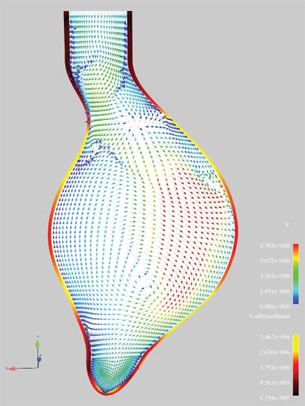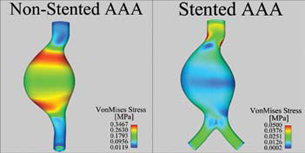Latest News
March 25, 2009
By Douglas Clark
|
Researchers at North Carolina State University (NCSU) are trying to help doctors predict the likelihood of abdominal aortic aneurysms (AAA), a condition that kills an estimated 15,000 people in the U.S. each year.
Anthony Santago, an undergraduate in NCSU’s Department of Mechanical and Aerospace Engineering, is working under the supervision of Professor Clement Kleinstreuer and his team of Ph.D. students and other collaborators to solve the “triple-A” dilemma so doctors can treat AAA with new or improved stent-graft designs to prevent deadly ruptures.
The Pressure is On
Aneurysms form when a weak segment in an artery wall balloons under the pressure of blood flow. Just like a weak spot in a bicycle inner tube that begins to bulge, the weakened wall of the artery will eventually burst, which leads to massive internal hemorrhaging and often death.
Aneurysms can form in the brain, heart, intestine, neck, and other areas, but most often occur in the aorta, which carries oxygenated blood from the heart to the organs. As the name indicates, the abdominal aortic aneurysm forms in a section of the aorta that runs through the abdomen, between the renal arteries and the iliacs that supply blood to the legs.
While much of how an aneurysm initially forms is clear, the progression of the condition is far from understood. Regardless of where aneurysms are located, it is difficult to predict their rate of development and when—if ever—they will rupture. Often, they expand sporadically, leaving doctors unsure when exactly treatment is optimal. Equally confounding, a relatively small aneurysm in one patient can unexpectedly rupture, while a comparatively larger and older aneurysm in another patient might never rupture. Because treatment can be risky in many cases, doctors are continually faced with weighing the risks of simply monitoring aneurysms and intervening surgically.
Seeing Inside Aneurysms
In the preliminary phase of Santago’s work, the aim was to take some of the mystery out of exactly how blood flow affects an aneurysm. Using medical imaging data provided by Dr. Mark A. Farber, an associate professor in surgery at the University of North Carolina at Chapel Hill, Santago created a solid model of an actual aneurysm. The geometry morphology was created using SolidWorks with dimensions based on average patient-specific values. He visualized pulsatile blood flow as well as wall stress contours based on the computer simulation work of former NCSU graduate students Zhonghua Li and Christopher Basciano.
|
“Once we’ve created a solid model, which consists of many nodes, we can then figure out what happens at each of these nodes during a simulation,” said Santago. “If we want blood to flow through the artery in a typical pulsing fashion, we can simulate this, outputting the data to a results file.”
The solid mechanics were modeled using ANSYS and the fluid dynamics were modeled using the native ANSYS flow solver FLOTRAN.
Santago then loaded the results file into EnSight, a visualization program from Computational Engineering International (CEI). An important goal of his work, however, goes beyond simply creating a visualization of the current data. He has used EnSight’s ability to produce command files to create a tool that will serve future AAA research. Any researcher will be able to essentially plug in his or her own results file to get a customized visualization.
“The idea is to get this to the point where anyone can take an instruction manual and the file and quickly adapt it to their own use,” says Santago.
INFO A ballooning problem Sending in reinforcements Only approved by the FDA in 1994, using stents in the arteries is a relatively new procedure that has saved many patients from more invasive surgery, such as bypass surgery. Read more about coronary stenting. |
The visualization shows the local flow rates and velocities over time as well as the Von Mises stresses. These results can be visualized for the entire aneurysm in a sagittal view and for four key points in axial views. In addition to accurately representing these characteristics, part of Santago’s work was to devise user-friendly graphics. For example, he worked with a number of color schemes before establishing the final version, which represents the workings of an aneurysm in colors that allow for optimal contrast between blood flow and arterial walls. Seemingly minor efforts such as these will save future researchers valuable time and allow them to perceive the finest level of detail more clearly.
Simulating Surgery
A second phase of the project involved studying the effectiveness of inserting endovascular stent grafts to prevent ruptures. In this increasingly common procedure, a tube of pliable material known as a graft is inserted inside the artery to shield the diseased area. Since the graft itself is not strong enough, a stent of wire mesh is added to serve as reinforcement.
EnSight is used to simulate the addition of a stent graft. “The pressure in an aneurysm can be very high, so the stent graft is put in place to shield and protect the diseased wall,” says Kleinstreuer. “Our simulations have shown that wall stress can be reduced by a factor of 20, and the pressure reduced by a factor of 8.5.”
Visualization work will continue in a third phase that will deal with stent-graft fatigue or slippage. The life-saving stents can sometimes slip by just a few millimeters, causing a sudden rush of blood to flow into the previously protected aneurysm and generally causes a rupture. Less severe, seepage can also occur around the stent graft, which leads to a slower accumulation of blood that can also lead to dangerous pressure on the weakened arterial wall. Furthermore, the stent wires in the mesh can experience micro-cracks due to material fatigue caused by the pulsatile blood flow. That, in turn, may lead to broken wires that poke holes into the graft material, causing major endoleaks.
The research will continue to study the effects of blood flow on AAA-rupture risk and on the stent graft itself to determine the ideal configuration for stent-graft placement and other factors that will help prevent failure. In addition to the computational analyses and fluid-structure-interaction visualizations, laboratory testing with synthetic replicas of patient-specific AAAs will be used to validate the computer simulations, and perhaps lead to improved stent-graft designs so ever more patients suffering from AAAs can live longer, healthier lives.
More Info
ANSYS, Inc.
Southpointe, PA
Computational Engineering International
Apex, NC
SolidWorks
Concord, MA
Douglas Clark is a freelance writer based in New York City and specializes in technology and information science. Send comments about this article to [email protected]
Subscribe to our FREE magazine, FREE email newsletters or both!
Latest News
About the Author
DE’s editors contribute news and new product announcements to Digital Engineering.
Press releases may be sent to them via [email protected].








